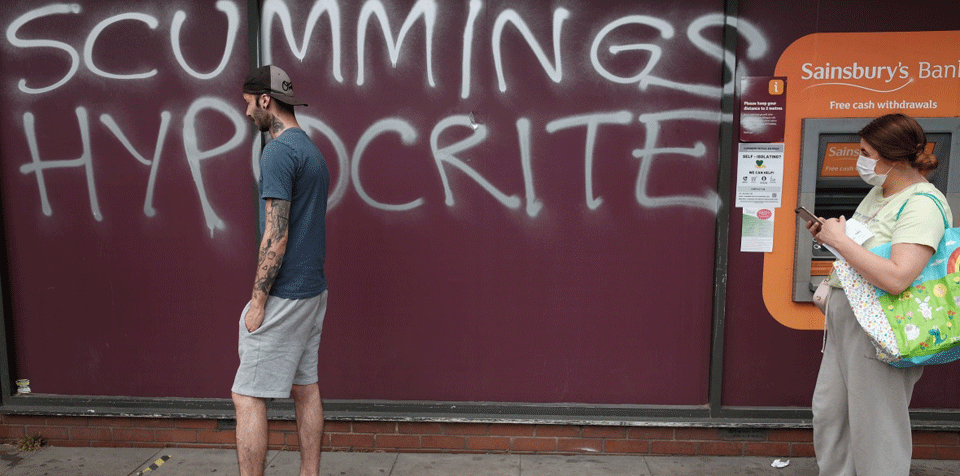
From mid-April onward the government came under intense pressure to start lifting the lockdown it had imposed on March 23.
A relatively early loosening of restrictions was supported by business groups and their cheerleaders in the right-wing press and the Cabinet (Chancellor Rishi Sunak, Home Secretary Priti Patel and perhaps Michael Gove too).
Pressure was also applied by the leaders of the Labour Party and the Scottish National Party.
Whatever the actual detail of their policy positions, it was obvious to anyone with a pulse how their public statements would be perceived by the media and wider political establishment.
“Keir Starmer calls for ministers to set out plans to end lockdown” was an April 15 headline in the Guardian.
“Ministers are under mounting pressure to reveal their plans for easing lockdown after senior Tories said that Nicola Sturgeon was right to outline her strategy for a ‘new normal’ in Scotland,” reported the Times newspaper on its front page on April 24.
Ranged against these forces — or at least not as gung-ho — were a number of powerful actors in the national debate.
For example, it has been widely reported Boris Johnson and Health Secretary Matt Hancock were both more cautious than many in the Cabinet when it came to lifting the lockdown.
Lots of experts stood in opposition to loosening the lockdown.
On May 7 Richard Horton, editor-in-chief of the Lancet medical journal, tweeted: “Dear Prime Minister — Please don’t dilute your policy of lockdown. Not yet. We have come so far. We need 3 more weeks.”
Writing in the Guardian on May 11, David Hunter, professor of epidemiology and medicine at the University of Oxford, argued: “If we … return to work in large numbers now — and without the ability to test, trace and isolate — then virus spread will increase, there will be super-spreader events and local or regional lockdowns will have to be reconsidered.”
Professor Devi Sridhar, chair of global public health at the University of Edinburgh, echoed these concerns when she appeared on BBC Question Time a few days later.
“We don’t have in place the basic building blocks of surveillance to actually know who has the virus,” she explained.
“And if the lockdown starts opening up now before we have the infrastructure in place, it’s basically pointless … what we are going to see is cases are going to go up … the virus is going to continue spreading and in a few weeks we are going to have this exact same debate again.”
Public opinion was also very cautious. A May 3 Opinium poll showed 67 per cent of respondents opposed to opening schools, 78 per cent and 81 per cent opposed to opening restaurants and pubs respectively, and 84 per cent against allowing mass gatherings at sports events or concerts to resume.
Similarly, 75 per cent of respondents answered it would be wrong for the government to start loosening lockdown now, according to a YouGov survey released on May 8.
These surveys are important because the Tory Party was “watching the polls closely,” according to an early April Guardian report.
A couple of weeks later a “Cabinet source” was quoted in the Telegraph discussing the government’s exit strategy from the lockdown.
“It [the government] is waiting for the public to change their mind,” it noted, after “We didn’t want to go down this route [of a lockdown] in the first place — public and media pressure pushed the lockdown.”
We now know, of course, the government didn’t wait for the public to change its mind.
Speaking to an estimated audience of 27.5 million, on May 10 the Prime Minister announced the loosening of the lockdown.
People who can’t work from home should be “actively encouraged” to return to work, Boris Johnson said.
He also said that people could now take unlimited outdoor exercise and outlined a phased plan to open primary schools and shops in June.
The Prime Minister’s statement demonstrated that business and economic interests had prevailed over public health concerns.
There are lots of signs that the easing of lockdown will be a disaster.
On May 7 Sir Ian Diamond, head of the Office for National Statistics, estimated there were 20,000 new cases a day in the UK — at least three times as many new cases as recorded by official statistics — according to the Times newspaper.
The day before the Sunday Times had reported the government target was 4,000 new cases a day.
We still seem a long way off from this — on June 5 the MRC Biostatistics Unit at Cambridge University estimated 17,000 new cases a day in England alone.
Citing the 20,000 figure, on May 7 John Edmunds, professor of infectious disease modelling at the London School of Hygiene and Tropical Medicine and a member of the government’s Scientific Advisory Group for Emergencies, explained that contact tracing was “probably impossible at the moment.”
This doesn’t bode well in light of the Guardian report on June 4: “the NHS coronavirus test-and-trace system designed to prevent a second deadly wave is not expected to work at full speed until September or October.”
Two days later the Independent highlighted the regional reproduction rate of the virus: “R is thought to be 1.01 in the northwest and 1 in the south-west, in results shown by a tool created by Public Health England (PHE) and Cambridge University.
“In only one region — the north-east and Yorkshire — was it below 0.9, the data suggested.”
The R number is the number of people each infected person, on average, passes the virus on to.
Lower than one means the pandemic is declining, higher than one means cases increase exponentially.
A May 11 British Medical Journal blog provides important context.
“The Rt [the R number] in Wuhan at this stage of lockdown was below 0.2,” explained KK Cheng, professor of public health and primary care at the University of Birmingham, and Wenjie Gong, associate professor at the Xiangya School of Public Health at Central South University in China.
The Prime Minister’s announcement on May 10 also highlighted how the British left has largely been MIA on coronavirus.
Starmer may be playing smart politics — he and the party are enjoying rising poll ratings — but arguably Labour has not been an effective opposition when it comes to taking strong positions on key facets of the crisis.
Instead there is an increasing sense the Labour leader is usually one step behind public opinion, rather than out in front, leading and shaping it.
This was well illustrated in April when Andrew Marr suggested to shadow chancellor Anneliese Dodds that her party was being “too gentle” on the government.
With Dodds equivocating on the question of loosening the lockdown when she was interviewed again by Marr on May 31, the BBC pussy-cat quoted Starmer’s recent statement: “We support the gradual easing of restrictions on lockdown” though “It’s got to be safe.”
Still Dodds was unable to give a clear answer, to which Marr responded: “You haven’t come off the fence and said whether you are in favour of the unlocking, or not in favour of the unlocking.”
More broadly, any influence the public has had on the government during the crisis has happened without a national grassroots campaign leading educating, organising and energising public opinion.
Where is the Occupy movement for the virus? The new Stop the War Coalition? The Campaign for Nuclear Disarmament of the crisis?
A senior Tory MP told the Guardian in early April they were “frankly amazed” the Prime Minister’s popularity was holding up.
“The death toll will become totemic,” they suggested. “If we get thousands of people dying every day for several days, who knows where this will go. It is frightening, and the Prime Minister looks like he doesn’t know what to do.”
With the official death toll now over 40,000 and Johnson’s personal ratings plummeting, this fear of the public means there is an opportunity for the left to have a real impact on government policy, the official opposition and the wider national debate during the biggest national crisis in a generation.
The $64,000 question is: will the British left rise to the challenge?
This article was reposted from Morning Star.









